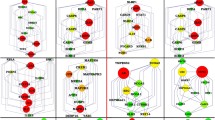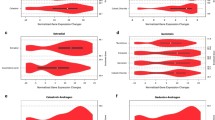Abstract
There are high preclinical attrition rates in current drug discovery. The efficient assessment approach in the high throughout candidate drugs screening still needs great improvement. We propose two hypotheses. First, both drug action process and biological process can be converted to a common space of gene or gene product profiling. Second, the strength of drug action on biological process can be realized in the context of biological network. Based on the above hypotheses, we establish an algorithm termed Network-based Assessment for Drug Action (NADA) to assess the action strength of candidate drugs on certain biological processes. Then NADA is used to prioritize the effects of six compounds from traditional Chinese medicine on endothelial cell migration, a simple process defined by Gene Ontology, in the biological network specific for a given pathological process, angiogenesis. The computational results are subsequently tested by the experiment on the migration of Human Umbilical Vein Endothelial Cells in vitro. The experimental ranks for six compounds generally agree with the predicted output of NADA. NADA also outperforms the DAVID and meet/min methods in terms of the experimental orders, suggesting that the network topological features may have a key role in catching the mechanistic relationship between drug action and biological process. Hopefully, the progress of network biology approaches for deciphering complex diseases will further expedite the preclinical screening and accelerate the development of treatment modalities.
Similar content being viewed by others
References
Hopkins A L. Network pharmacology: The next paradigm in drug discovery. Nat Chem Biol, 2008, 4: 682–690
Barabasi A L, Oltvai Z N. Network biology: Understanding the cell’s functional organization. Nat Rev Genet, 2004, 5: 101–113
Goh K I, Cusick M E, Valle D, et al. The human disease network. Proc Natl Acad Sci USA, 2007, 104: 8685–8690
Wu X, Jiang R, Zhang M Q, et al. Network-based global inference of human disease genes. Mol Syst Biol, 2008, 4: 189
Feldman I, Rzhetsky A, Vitkup D. Network properties of genes harboring inherited disease mutations. Proc Natl Acad Sci USA, 2008, 105: 4323–4328
Kitano H. A robustness-based approach to systems-oriented drug design. Nat Rev Drug Discov, 2007, 6: 202–210
Chen Y, Zhu J, Lum P Y, et al. Variations in DNA elucidate molecular networks that cause disease. Nature, 2008, 452: 429–435
Korcsmaros T, Szalay M S, Bode C, et al. How to design multi-target drugs: Target search options in cellular networks. Expe Opin Drug Discov, 2007, 2: 1–10
Paolini G V, Shapland R H, van Hoorn W P, et al. Global mapping of pharmacological space. Nat Biotechnol, 2006, 24: 805–815
Grimaldi D, Claessens Y E, Mira J P, et al. Beyond clinical phenotype: The biologic integratome. Crit Care Med, 2009, 37(1 Suppl): S38–S49
Loscalzo J, Kohane I, Barabasi A L. Human disease classification in the postgenomic era: A complex systems approach to human pathobiology. Mol Syst Biol, 2007, 3: 124
Wishart D S, Knox C, Guo A C, et al. DrugBank: A knowledgebase for drugs, drug actions and drug targets. Nucleic Acids Res, 2008, 36 (Database issue): D901–D906
Yildirim M A, Goh K I, Cusick M E, et al. Drug-target network. Nat Biotechnol, 2007, 25: 1119–1126
Sams-Dodd F. Target-based drug discovery: Is something wrong? Drug Discov Today, 2005, 10: 139–147
Lamb J, Crawford E D, Peck D, et al. The Connectivity Map: Using gene-expression signatures to connect small molecules, genes, and disease. Science, 2006, 313: 1929–1935
Yancopoulos G D, Davis S, Gale N W, et al. Vascular-specific growth factors and blood vessel formation. Nature, 2000, 407: 242–248
Carmeliet P. Angiogenesis in life, disease and medicine. Nature, 2005, 438: 932–936
Abdollahi A, Schwager C, Kleeff J, et al. Transcriptional network governing the angiogenic switch in human pancreatic cancer. Proc Natl Acad Sci USA, 2007, 104: 12890–12895
Li S, Wu L J, Zhang Z Q. Constructing biological networks through combined literature mining and microarray analysis: A LMMA approach. Bioinformatics, 2006, 22: 2143–2150
Fan T P, Yeh J C, Leung K W, et al. Angiogenesis: From plants to blood vessels. Trends Pharmacol Sci, 2006, 27: 297–309
Cleaver O, Melton D A. Endothelial signaling during development. Nat Med, 2003, 9: 661–668
Peri S, Navarro J D, Amanchy R, et al. Development of human protein reference database as an initial platform for approaching systems biology in humans. Genome Res, 2003, 13: 2363–2371
He Z H, He M F, Ma S C, et al. Anti-angiogenic effects of rhubarb and its anthraquinone derivatives. J Ethnopharmacol, 2009, 121: 313–317
Huang da W, Sherman B T, Lempicki R A. Systematic and integrative analysis of large gene lists using DAVID bioinformatics resources. Nat Protoc, 2009, 4: 44–57
Goldberg D S, Roth F P. Assessing experimentally derived interactions in a small world. Proc Natl Acad Sci USA, 2003, 100: 4372–4376
Kanehisa M, Araki M, Goto S, et al. KEGG for linking genomes to life and the environment. Nucleic Acids Res, 2008, 36(Database issue): D480–D484
Jeong H, Mason S P, Barabasi A L, et al. Lethality and centrality in protein networks. Nature, 2001, 411: 41–42
Maslov S, Sneppen K. Specificity and stability in topology of protein networks. Science, 2002, 296: 910–913
Ma H W, Zeng A P. The connectivity structure, giant strong component and centrality of metabolic networks. Bioinformatics, 2003,19: 1423–1430
Page L, Brin S, Motwani R, et al. The PageRank citation ranking: Bringing order to the Web. In: Proceedings of the 7th International World Wide Web Conference, 1998. 161–172
Carmeliet P. Mechanisms of angiogenesis and arteriogenesis. Nat Med, 2000, 6: 389–395
Li S, Zhang N, Zhang B. Method of Network-based Identification of Multicomponent Synergy (NIMS). Chinese Patent. 200810239284.4, 2008-12-8
Smith L L. Key challenges for toxicologists in the 21st century. Trends Pharmacol Sci, 2001, 22: 281–285.
Simon-Hettich B, Rothfuss A, Steger-Hartmann T. Use of computer-assisted prediction of toxic effects of chemical substances. Toxicology, 2006, 224: 156–162
Araujo R P, Liotta L A, Petricoin E F. Proteins, drug targets and the mechanisms they control: The simple truth about complex networks. Nat Rev Drug Discov, 2007, 6: 871–880
Nicholson J K, Connelly J, Lindon J C, et al. Metabonomics a platform for studying drug toxicity and gene function. Nat Rev Drug Discov, 2002, 1: 153–161
Nicholson J K, Wilson I D. Understanding ‘global’ systems biology: Metabonomics and the continuum of metabolism. Nat Rev Drug Discov, 2003, 2: 668–676
Nicholson J K, Holmes E, Lindon J C, et al. The challenges of modeling mammalian biocomplexity. Nat Biotech, 2004, 22: 1268–1274
Borisy A A, Elliott P J, Hurst N W, et al. Systematic discovery of multicomponent therapeutics. Proc Natl Acad Sci USA, 2003, 100: 7977–7982
Hopkins A L. Network pharmacology. Nat Biotechnol, 2007, 25: 1110–1111
Schadt E E, Friend S H, Shaywitz D A. A network view of disease and compound screening. Nat Rev Drug Discov, 2009, 8: 286–295
Lee D S, Park J, Kay K A, et al. The implications of human metabolic network topology for disease comorbidity. Proc Natl Acad Sci USA, 2008, 105: 9880–9885
Jorgensen W L. The many roles of computation in drug discovery. Science, 2004, 303: 1813–1818
L’Esperance S, Bachvarova M, Tetu B, et al. Global gene expression analysis of early response to chemotherapy treatment in ovarian cancer spheroids. BMC Genomics, 2008, 9: 99
Lehar J, Zimmermann G R, Krueger A S, et al. Chemical combination effects predict connectivity in biological systems. Mol Syst Biol, 2007, 3: 80
Araujo R P, Doran C, Liotta L A, et al. Network-targeted combination therapy: A new concept in cancer treatment. Drug Discov Today Ther Strateg, 2004, 1: 425–433
Hakes L, Pinney J W, Robertson D L, et al. Protein-protein interaction networks and biology-what’s the connection? Nat Biotech, 2008, 26: 69–72
Li S, Zhang Z Q, Wu L J, et al. Understanding ZHENG in traditional Chinese medicine in the context of neuro-endocrine-immune network. IET Syst Biol, 2007, 1: 51–60
Li S, Lu A P, Wang Y Y, et al. Suppressive effects of a Chinese herbal medicine Qing-Luo-Yin extract on the angiogenesis of collagen induced arthritis in rats. Am J Chin Med, 2003, 31: 713–720
Wu M, Ma C, Wu Y, et al. Simultaneous LC analysis of five bioactive alkaloids in an anti-angiogenesis herbal formula, Qing-Luo-Yin. Chromatographia, 2008, 68: 579–585
Author information
Authors and Affiliations
Corresponding author
Additional information
These authors contributed equally to this work.
About this article
Cite this article
Li, L., Zhang, N. & Li, S. Ranking effects of candidate drugs on biological process by integrating network analysis and Gene Ontology. Chin. Sci. Bull. 55, 2974–2980 (2010). https://doi.org/10.1007/s11434-010-4067-6
Received:
Accepted:
Published:
Issue Date:
DOI: https://doi.org/10.1007/s11434-010-4067-6




